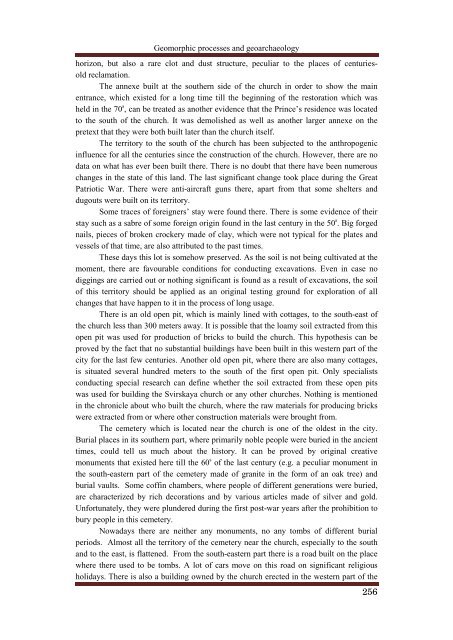extended abstracts - Geomorphic Processes and Geoarchaeology
extended abstracts - Geomorphic Processes and Geoarchaeology
extended abstracts - Geomorphic Processes and Geoarchaeology
You also want an ePaper? Increase the reach of your titles
YUMPU automatically turns print PDFs into web optimized ePapers that Google loves.
<strong>Geomorphic</strong> processes <strong>and</strong> geoarchaeology<br />
horizon, but also a rare clot <strong>and</strong> dust structure, peculiar to the places of centuriesold<br />
reclamation.<br />
The annexe built at the southern side of the church in order to show the main<br />
entrance, which existed for a long time till the beginning of the restoration which was<br />
held in the 70 s , can be treated as another evidence that the Prince’s residence was located<br />
to the south of the church. It was demolished as well as another larger annexe on the<br />
pretext that they were both built later than the church itself.<br />
The territory to the south of the church has been subjected to the anthropogenic<br />
influence for all the centuries since the construction of the church. However, there are no<br />
data on what has ever been built there. There is no doubt that there have been numerous<br />
changes in the state of this l<strong>and</strong>. The last significant change took place during the Great<br />
Patriotic War. There were anti-aircraft guns there, apart from that some shelters <strong>and</strong><br />
dugouts were built on its territory.<br />
Some traces of foreigners’ stay were found there. There is some evidence of their<br />
stay such as a sabre of some foreign origin found in the last century in the 50 s . Big forged<br />
nails, pieces of broken crockery made of clay, which were not typical for the plates <strong>and</strong><br />
vessels of that time, are also attributed to the past times.<br />
These days this lot is somehow preserved. As the soil is not being cultivated at the<br />
moment, there are favourable conditions for conducting excavations. Even in case no<br />
diggings are carried out or nothing significant is found as a result of excavations, the soil<br />
of this territory should be applied as an original testing ground for exploration of all<br />
changes that have happen to it in the process of long usage.<br />
There is an old open pit, which is mainly lined with cottages, to the south-east of<br />
the church less than 300 meters away. It is possible that the loamy soil extracted from this<br />
open pit was used for production of bricks to build the church. This hypothesis can be<br />
proved by the fact that no substantial buildings have been built in this western part of the<br />
city for the last few centuries. Another old open pit, where there are also many cottages,<br />
is situated several hundred meters to the south of the first open pit. Only specialists<br />
conducting special research can define whether the soil extracted from these open pits<br />
was used for building the Svirskaya church or any other churches. Nothing is mentioned<br />
in the chronicle about who built the church, where the raw materials for producing bricks<br />
were extracted from or where other construction materials were brought from.<br />
The cemetery which is located near the church is one of the oldest in the city.<br />
Burial places in its southern part, where primarily noble people were buried in the ancient<br />
times, could tell us much about the history. It can be proved by original creative<br />
monuments that existed here till the 60 s of the last century (e.g. a peculiar monument in<br />
the south-eastern part of the cemetery made of granite in the form of an oak tree) <strong>and</strong><br />
burial vaults. Some coffin chambers, where people of different generations were buried,<br />
are characterized by rich decorations <strong>and</strong> by various articles made of silver <strong>and</strong> gold.<br />
Unfortunately, they were plundered during the first post-war years after the prohibition to<br />
bury people in this cemetery.<br />
Nowadays there are neither any monuments, no any tombs of different burial<br />
periods. Almost all the territory of the cemetery near the church, especially to the south<br />
<strong>and</strong> to the east, is flattened. From the south-eastern part there is a road built on the place<br />
where there used to be tombs. A lot of cars move on this road on significant religious<br />
holidays. There is also a building owned by the church erected in the western part of the<br />
256


